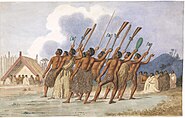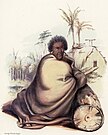| The Musket Wars | |||||||
|---|---|---|---|---|---|---|---|
| |||||||
| |||||||
| Belligerents | |||||||
| Various Māori tribes | |||||||
| Casualties and losses | |||||||
|
Up to 40,000 Māori 30,000 enslaved or forced to migrate 300 Moriori deaths, 1700 Moriori enslaved | |||||||
The Musket Wars were a series of as many as 3,000 battles and raids fought throughout New Zealand (including the Chatham Islands) among Māori between 1806 and 1845,[1] after Māori first obtained muskets and then engaged in an intertribal arms race in order to gain territory or seek revenge for past defeats.[2] The battles resulted in the deaths of between 20,000 and 40,000 people and the enslavement of tens of thousands of Māori and significantly altered the rohe, or tribal territorial boundaries, before the signing of the Treaty of Waitangi in 1840.[3][4] The Musket Wars reached their peak in the 1830s,[5] with smaller conflicts between iwi continuing until the mid-1840s; some historians argue the New Zealand Wars were (commencing with the Wairau Affray in 1843 and Flagstaff War in 1845) a continuation of the Musket Wars.[6] The increased use of muskets in intertribal warfare led to changes in the design of pā fortifications, which later benefited Māori when engaged in battles with colonial forces during the New Zealand Wars.[6]
Ngāpuhi chief Hongi Hika in 1818 used newly acquired muskets to launch devastating raids from his Northland base into the Bay of Plenty, where local Māori were still relying on traditional weapons of wood and stone. In the following years he launched equally successful raids on iwi in Auckland, Thames, Waikato and Lake Rotorua,[3] taking large numbers of his enemies as slaves, who were put to work cultivating and dressing flax to trade with Europeans for more muskets. His success prompted other iwi to procure firearms in order to mount effective methods of defence and deterrence and the spiral of violence peaked in 1832 and 1833, by which time it had spread to all parts of the country except the inland area of the North Island later known as the King Country and remote bays and valleys of Fiordland in the South Island. In 1835, the fighting went offshore as members of Ngāti Mutunga and Ngāti Tama invaded and murdered the Moriori of Rēkohu in a genocide.
With as many as 40,000 killed over a 40-year period, the death toll of the Musket Wars was absolutely unprecedented. Historian Michael King suggested the term "holocaust" could be applied to the period;[7] another historian, Angela Ballara, has questioned the validity of the term "musket wars", suggesting the conflict was no more than a continuation of Māori tikanga (custom), but more destructive because of the widespread use of firearms.[8] The wars have been described as an example of the "fatal impact" of indigenous contact with Europeans.[8]
- ^ Crosby 1999, p. 1.
- ^ Bohan, Edmund (2005). Climates of War: New Zealand Conflict 1859–69. Christchurch: Hazard Press. p. 32. ISBN 9781877270963.
- ^ a b Keane, Basil (2012). "Musket wars". Te Ara, the Encyclopedia of New Zealand. Ministry for Culture and Heritage. Retrieved 4 November 2015.
- ^ Sinclair, Keith (2000). A History of New Zealand (2000 ed.). Auckland: Penguin. pp. 41–42. ISBN 978-0-14-029875-8.
- ^ Crosby 1999, p. 23.
- ^ a b O'Malley 2019, p. 19.
- ^ Michael King (2003). The Penguin History of New Zealand. Penguin Books. pp. 131–139. ISBN 978-0-14-301867-4.
- ^ a b Watters, Steve (2015). "Musket wars". New Zealand History. Ministry for Culture and Heritage. Retrieved 5 November 2015.





